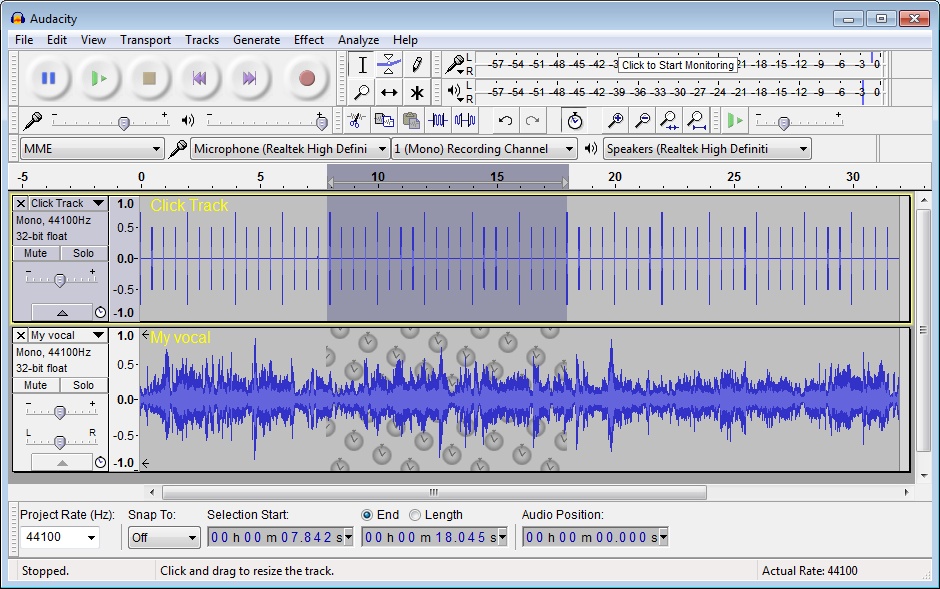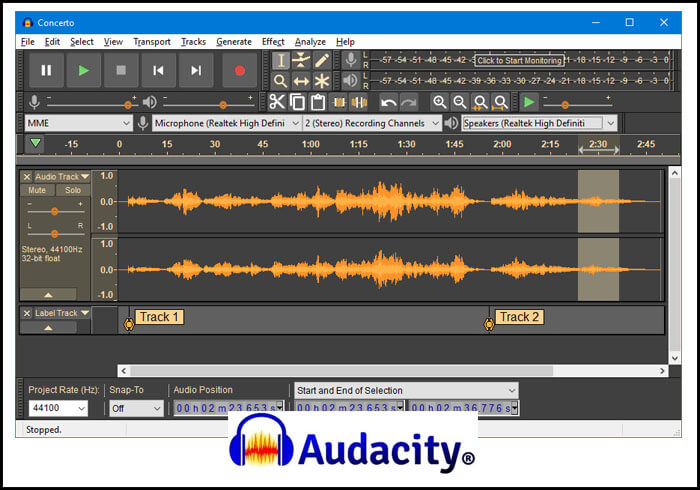Audacity does not itself support 8-bit recording. 16-bit is the nearest option. It is possible to export files in an 8-bit format, though Audacity defaults to exporting as 16-bit. Audacity's 3.0 update, in March 2021, introduced a new project file format,.aup3, using SQLite database to store everything. Audacity supports only 32-bit or 64-bit VST audio effect plug-ins, depending on which architecture it was built for, but not both at the same time. It is built in 32-bit for Windows and 64-bit for macOS. (Windows) Audacity 2.1.0 requires Windows XP SP3 (32-bit) or XP SP2 (64-bit), Vista, Windows 7, Windows 8 or 8.1. (Windows) Audacity is now compiled using Visual Studio 2013. (Windows) Recording with WASAPI host now includes experimental support for physical inputs (up to 24-bit depth) as well as loopback recording. Audacity lets you record in either 16-bit or 24-bit audio. One of Audacity's best qualities is that it can smoothly convert and combine any sounds you drag in, regardless of sample rate and formats.
Convert bitrate of your .WAV file using Audacity.
If your end goal is to create a true Audio CD (that can be played in a CD player) your .WAV files must be in this exact format:
16 bit
1411 Kbps
44Khz (44.1)
You may have been editing your .WAV files in a higher 24bit or 32bit format, but to actually record to an Audio CD, they need to be down-converted to the slightly lower quality 16bit 1411Kbps format. Audio CD players read files only in this format, so you can't put 24bit or 32bit higher bitrate files on a true Audio CD.
We recommend the Audacity audio software because it's FREE, open source, can be used in Windows and Macs, and does many things besides just converting bitrate.
Visit http://www.audacityteam.org/download/ to download and install for both Windows and Mac. We've tested this software as safe from adware or any malware etc. If you are concerned with viruses (as you should), visit SoftPedia.com to find trusted information about any kind of software you might think to install.
First, you need to drag and drop your .WAV files from where you have them stored on your computer directly onto the Audacity program to load them.
In this case, you can see the bitrate of these files is 2116kbps. On your computer, you may have to right click and look at properties to find the bitrate.
Audacity 16 Bit Mono
Audacity 16 Bit Audio
This is how it looks when your .WAV files have loaded into the Audacity Window.
You do not need to change any default program settings.

Audacity 16 Bit File
Choose File - Save Other - Export Multiple...
By exporting the file(s), it converts to 16 bit 1411kbps file(s).
Audacity 16 Bit
Choose the WAV (Microsoft) signed 16-bit PCM format. By default, this 16 bit output format will convert the bitrate to 1411kbps.
Pick the output folder.
You don't need to choose the option to 'Overwrite existing files'.
Audacity Convert 16 Bit
Find your exported .WAV files on your computer.
Right click on one of your files to find properties. Look at the Details tab. This is where you should see the bitrate for your new files. It should be 1411kbps which is the correct format for an Audio CD.

